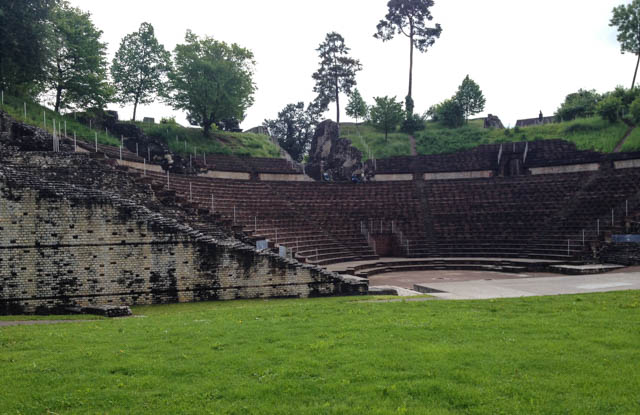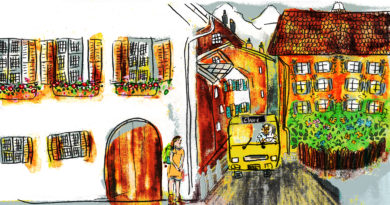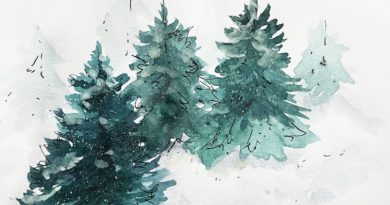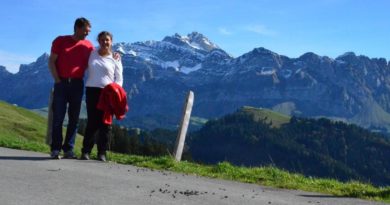Roman Footsteps in Switzerland
Visiting Augusta Raurica in August, Basel-Land
When you think of Switzerland today you might think of the cheeses and chocolates, knives and watch-making, banking, insurances and pharmaceuticals for which the Swiss are world renowned. If you travel in rural Switzerland you might see cows wearing magnificent bells grazing on alpine hills on the foot snowy mountains populated by farmers and herdsmen who yodel and play alp horns. You might have heard of the stories of William Tell and the apple he shot off his son’s head or the oath that was taken in 1291 to form the Confederation Helvetia (the Swiss Confederation). This is the image of Switzerland I had when I arrived in the country I now call home. This Switzerland is both wonderful and real, and yet there is another side to Switzerland, its people and their history, than these images indicate. In the next few “Out and About” columns I will write about topics and places in Switzerland that might surprise you and your family. One such place is Augusta Raurica in Augst, Basel-Land.
Augusta Raurica was a Roman colony located along the southern banks of the Upper Rhein Valley in present-day Augst. None other than Julius Caesar ordered General Munatius Plancus to establish a colony, which was later expanded under Emperor Augustus. Initially the Rauriker, a Celtic tribe, were settled there. These two cultures co-inhabited the area. The Romans established temples, which intermingled the Celtic belief system with that of the Romans, an amphitheatre and theatre, as well as baths, a large market place, and villas. Today, the ruins and partial reconstruction of parts of the former city and a noteworthy museum are open to the public and definitely give a very different view of Switzerland from the first to the fourth century AD than one might expect.
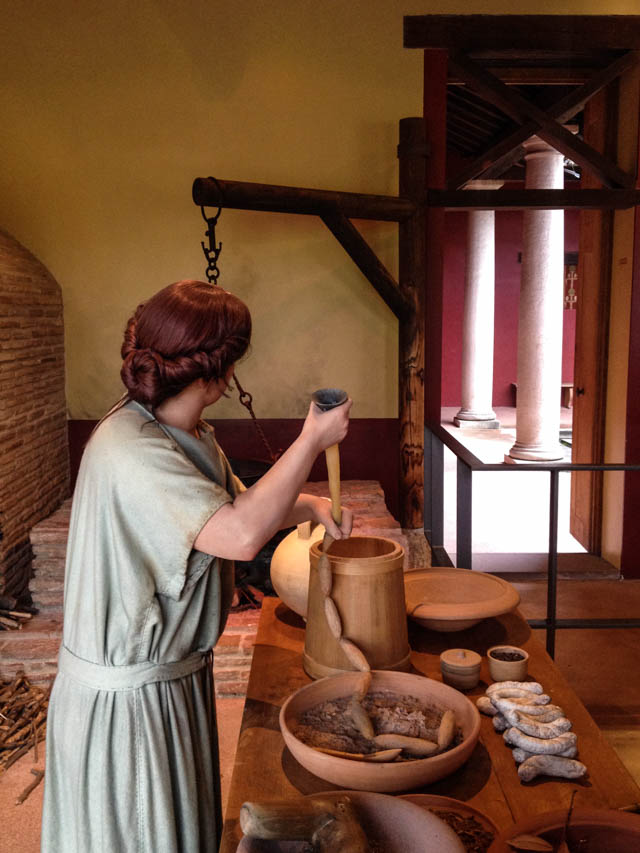
I was there over the Pentecost (Pfingsten) weekend with my family and friends. Not only is there enough space to run around and stroll, as the Roman area covers three square kilometers, but the information is also presented in English. The plaques provide detailed and fascinating technical and historical information, as well as interesting facts for kids. Children meet the Roman youth Marcus, a fictional character, and can follow a path with many plaques describing how gladiators lived. These contain information and quiz questions that we had a tough time answering correctly. For instance, Q: Who decided whether a gladiator lived or died after the fight? a. the emperor; b. the people; c. the organizer?

If you want to know the answer, you will have to visit Augusta Raurica! My young adults did, however, notice that answers drawn from films, games, and television were usually incorrect!
For me, the baths and the roof tile factory were the most interesting ruins. It was amazing how advanced the culture was – able to fire furnaces up to 1000 degrees centigrade in order to make tiles, and producing a home heating system with ceramic plates and tubes located throughout the bath house. The museum was also fascinating. Young children will certainly like the current exhibit: Children? Children! Searching for Clues in Augusta Raurica, about the lives of Roman children. There is a document (PDF) for adults, in English, which I suggest you read ahead of your trip to make your children’s visit exciting.
The reconstructed villa and the largest collection of Roman silver in Europe was my middle son’s favorite aspect. My son noticed that the sophistication of the long-ago Roman households sharply contrasts with the primitive lives of Swiss alpine herdsmen and cheese-makers who lived just 80 years ago. Quite a revelation for him. Not that Roman life was easy! While traversing the outer perimeter we happened upon two men marching within an arena shouting “Uno, Due, Tre…” (one, two, three in Italian). They wore breeches wrapped around like a diaper and a thick leather belt and carried daggers and shields. We had come across gladiator characters practicing for Roman games! Well my youngest son was thrilled, as were we all. They were practicing different fighting techniques. There will be a huge Roman festival, Panem et Circensus, on the premises from the 26th -28th August. It will include chariot races, gladiator fights, weaving, music making and everything else you could imagine from that period.
Clearly we just touched on what Augusta Raurica has to offer during our visit. We will return this summer for the festival, and my kids are interested in participating in some workshops if they can find the time. Do set aside at least a day for your visit. Unfortunately there is no restaurant on site, but just a few meters away there are cafes, a pizzeria, and a Thai Imbiss. We brought a picnic, as there are areas for picnicking. During the Roman festival, food will be sold.
Tickets are available at ticket corner for one or two days.
Roman Festival Panem et Circensus
http://www.ticketcorner.ch/tickets.html?fun=erdetail&affiliate=tcs&doc=erdetaila&erid=1614872
Prices begins at around 18.80 CHF for 1 day or 31 CHF for both days
Before traveling to Augusta Raurica I would suggest you download the app Making the Visible Visible free of charge from the Apple iTunes store or the Google Playstore. This app allows you to see what Augusta Raurica would have looked like during the Roman times and is quite useful.
You and your family or a group can take a tour by contacting their visitor service, tel. +41 (0)61 552 22 22 or mail@augusta-raurica.ch.
I suggest you go to the the website for general information. There is abundant parking and the address is: Augusta Raurica Museumskasse, Giebenacherstrasse 17, 4302 Augst BL. Check out possible workshops for adults, which my older children think they might enjoy.
Cool things for your school-aged children to do:
Wachstafel & Griffel – Bastle deine eigenen römischen Schreibgeräte (Waxboard and stylus- make your own Roman writing tools). Cost: 16 CHF. On the following dates: 12 June , 10 July , and 14 August 2016 , from 13:00-14:30.
Roman play afternoon where families play the games which Roman children might have played (free)
Sundays until 21 August, from 13:00-16:00.
Herb and Harz Mischungen Göttliche Düfte – Räuchermischungen nach römischer Art
(Herb and Resin Mixtures-Fragrances-Incense mixtures in the Roman Style) Cost: 16 CHF.
On the following dates: 29 May , 06 June, and 24 July 2016 , from 13:00 – 14:30
Salben und Öle in der Antike (Ointments and Oils in the Classical Era: Learn about herbs used to make medicinal ointments following original Roman recipes). Cost: 16 CHF. On the following dates: 26 June, 13 July, and 25 September 2016, from 13:00-14:30.
In addition there are events planned during the summer to be held at the amphitheatre, which although not necessarily Roman could be fun! For example, Theatre Basel will perform the Tragi-comedy Twelfth Night (Was Ihr Wollt) by William Shakespeare on 13, 16 and 18 August 2016.
A Tale of Christ composed by Steve Copeland in 2009 will be performed by the Symphony Orchestra of Basel to the black and white silent film BEN HUR from Fred Niblo in 1925. From 25 to 28 August 2016.
If you or your children catch the Roman-Swiss bug there is a gift shop at Augusta Raurica where you can buy shields, mini home deities and some quite interesting books. In particular there is a book series about the lives of two Roman children, Prisca and Silvanus, who lived in Augusta Raurica, which my sons would highly recommend! Unfortunately they are only printed in German and French. But if your children have even a low- to intermediate German level, they will enjoy these comic-type books by the Swiss writer Dorothée Simko.
Also there are other settlements or fortress sites to visit in Switzerland. Below I list just a couple we have visited.
Avenches, or the Roman capital of the Helvetii, Aventicum, which has a good museum and amphitheatre as well as beautiful mosaics. You might be able to watch excavations.
Windisch in Canton Aargau, Roman Vindonissa, was a legionnaires’ fort where you can view an intact Roman aqueduct and an amphitheatre and a museum.
Text and photos by Dr. Teresa Müller
Teresa is an earth scientist and instructor by education and an avid traveler and adventurer by nature. She has three sons ages 32, 19, and 16.

